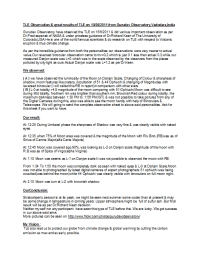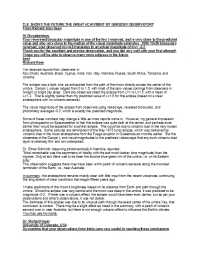Lunar Eclipse
An eclipse is one of the wonderful celestial events, it shows nature's miracle. The Lunar Eclipse is one of them. It helps us to study various astronomical and celestial phenomena, especially climate, global warming and the stratosphere. We use each eclipse to train and educate youth and students.
We have observed
Among several Lunar Eclipses which we have observed over several years include the TLE on 15/06/2011 which was a fantastic chance to study the stratosphere, climate condition and to predict future weather paterns. Our results are given below.
We used
During TLE, though it was a naked eye event, we used several optical instruments, including a Mead 4” telescope, 2” Germany made refractor, a pair of 10-22x50 Nikon binoculars and two pairs of Germany made binoculars to have more details of the moon. A Sony Handy cam was also used to photograph the event.
National Media
More than 50 reporters, editors and video photographers attended from
- all leading TV channels like DD News (with O.B.van for live telecast), Star News, India TV, Sahara Samay, Aajtak, IBN7, NDTV,
- all leading News papers like Divyabhaskar group, Gujarat Samachar, Sandesh, Loksatta & Indian Express Group, Times of India group, Gujarat Mitra,
- All local TV channels,
- all FM Radios have enjoyed the event through the eye of space science which - after the event - was deliver to millions of Indians by them.
Best event for Education
A Lunar Eclipse is one of the best events for education because
- It does not require any costly equipment like a large telescopes, so even a poor community can see the eclipse and learn about the phenomenon.
- It can be observed from anywhere within the path of the eclipse and there is no need to make special arrangements.
- It can help to interest the public in space and astronomy.
Gallery of pictures
TLE observation & great results of TLE on 15/06/2011 from Gurudev Observatory, Vadodara, India
Gurudev Observatory has observed the TLE on 15/6/2011 and did various important observation for Dr. Fred Espenak of NASA and under the priceless guidance of Dr. Richard Keen of the University of Colorado, USA. He is a world famous scientists and researches TLEs with respect to volcanic eruptions and thus climate change.
As per the incredible guidance from both experts our observations were very close to actual values. Our reversed binocular observation came to mv=0.2 which is just 0.1 less then actual 0.3, while our measured Danjon scale was L=0 which was in the scale observed by the observers from the places polluted by city light as ours. Actual Danjon scale was L=1.2 as per Dr. Keen.
We observed
- we have observed the luminosity of the Moon on Danjon Scale, changing of colour and sharpness of shadow, moon features like craters, occultation of 51 and 44 Ophiuchi and the changing of magnitudes with reversed binocular (I will called this RB in report) in comparison with other stars.
- L-0 at totality, +4.8 magnitude of the moon comparing with 51-Ophiuchi, the Moon was difficult to see during mid totality, the northern rim was brighter than southern rim, brownish red colour during totality, the maximum darkness between 1:30 PM to :1:56 PM (IST). Unfortunately it was not possible to take pictures from any of the digital cameras during this, and it was difficult to see the moon also was able to see the moon with the help of binoculars and telescopes. We are going to send the complete observation sheet to above experts. Ask for this sheet if you would like a copy.
Our results
At 12:25 During Umbaral phase the sharpness of shadow was very fine and was clearly visible with naked eyes.
At 12:35 when 75% of the Moon's area was covered and the magnitude of the Moon with Reversed Binooculars (RB) was similar to Sirius in Cannis Major (alpha Canis Majoris)
At 12:45 Moon was covered app.90%, was looking as L-2 on the Danjon scale. Magnitude of the moon with R.B. was as of Spica in Virgo (alpha Virginis)
At 1:10 Moon appeared as L-1 on the Danjon scale. It was not possible to observed the moon with RB.
From 1:34 To 1:50 the moon was completely dark as seen with naked eyes and L-0 on the Danjon Scale. It was not possible to photograph the Moon while 51 Ophiuchi was being occulted (was behind the moon) even with the latest digital cameras used by expert photographers. 44 Ophiuchi was clearly visible with binoculars on full moon night.
At 2:10 Moon was turn at L-2 with brownish shadow.
TLE observation:
TLE shows the future:
Our Conclusion
Stratoshperic aerosol is at its peak, we might be seen next summer some cooler than at present and there may be some change in temperature in the coming years. The upper atmosphere might be full of sulfur ash. But final result will be as per Dr. Richard Keen's decision.
Neither myself nor any participant have seen this type of TLE before this. We are lucky. We got success in our above said aims.
More pictures can be seen on http://www.flickr.com/photos/gurudevobservatory/
My Vision
TLE also lead us to protect our globe from climate change and global warming by cutting the carbon emission as much and as early possible.











